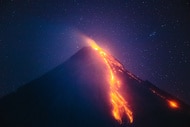Create a free profile to get unlimited access to exclusive videos, sweepstakes, and more!
Plaitgiarism

Every now and again I hear about a writer who is accused of plagiarism, and they claim they must have read the plagiarized passage and forgot it, only to have it surface in their brain in what they think is an original idea.
That always seemed pretty far-fetched to me. Until a few days ago.
When I see something interesting on the web but don't have time to write about it, I'll create a Word doc with the link in it, and then save it to my desktop. Then I can go through them at my leisure and write something when I need to.
I did this recently, and found a saved note about a link debunking the idea that the Canary Island of La Palma can suffer a massive landslide that could cause a megatsunami. Hey, that'll be good for the blog, I thought. I read the links, and started writing. When I was done, I needed to get an image of La Palma for the article. I knew I had written about the volcano before, so I searched my blog to find a good pic.
And what I found was… well. Let me show you.
First, here is the article I just wrote after finding the link on my desktop. Like I said, it's only 650 words so it won't take long to read it.
Back in 1998, I was working on a small project to use Hubble to look for nearby brown dwarfs, which had only recently been discovered to exist. At the same time, a conference on the detection and theoretical modeling of these weird objects was being held on the Canary island of La Palma, and I was able to secure funding to attend.
It was a fascinating conference, and I learned a vast amount (which, of course, has shrunk to insignificance compared to what we've learned since then). But I actually want to write about the venue, and something I learned about it there and later.
The Canaries are very similar to the chain of Hawaii islands, formed by a "hot spot," a plume of hot material rising through the Earth's mantle. This pokes through the crust and forms islands via volcanism, and as the crust moves due to continental drift you get islands chains.
So each island is really just a sea volcano! La Palma is dominated by a huge caldera called Taburiente, which is 9 km across, and the volcano is still active.
The interesting thing is that on the western flank of the volcano a huge chunk is missing. This wedge-shaped scarp is truly enormous, and was created in a massive landslide a little over 550,000 years ago. Something like 200 cubic kilometers of volcano slid into the Atlantic Ocean! That is destruction on a ridiculously massive scale.
I saw this gigantic scar in the volcano for myself, then studied it more after I got home. I perused satellite images, read some articles, and so on. I was curious; it's hard to imagine there wasn't a megatsunami created when that much rock slammed into the ocean! The simple displacement of water must have been tremendous. And, in fact, I watched several documentaries on TV making this very claim.
I found it weird, though, that there was no evidence for it on the US east coast, or anywhere else. Still, I ate up those TV shows, and read what I could. I learned a lot about these natural disasters at the time, including one hypothesis that another chunk of the volcano is also ready to let go, and when it does, it'll be bad…
But now it looks like the effects of this, and even the threat of it, were exaggerated. On the wonderful Landslide Blog, Dave Petley wrote a two part article (part 1, part 2) about the megatsunami idea and why it seems likely to be overblown. He doesn't see much evidence that the island is ready to crumble, points out that the fault scarp hasn't reactivated in recent eruptions, and shows that papers promoting the megatsunami idea seem to jump straight to worst case scenarios, which isn't warranted. Wikipedia has more info on this as well.
This is good news! Megadisasters are terrifying, and it's nice to know at least in this case that the odds of it occurring are vanishingly small.
But it's also aggravating that the issue was sensationalized. Several documentaries presented this idea as well established, when in fact it was not. Megatsunamis are real — read about the Alaska Lituya Bay landslide-induced megatsunami if you never want to sleep again — but in this case, La Palma is not a threat.
I'm a scientist, trained as one and employed as one for many years to plumb the depths of the Universe. Because of that, I think, I was able to take in the new evidence and appreciate that what I thought before was wrong. But it's important to note that I bought into the idea in the first place. The evidence looked good, and of course it wasn't my field, so in this case I was just an educated layman.
It's a good reminder to question what you think you know, your evidence for it, and even the base assumptions about it. Landslides and tsunamis are scary, but in a personal way so are faulty beliefs. Sometimes it's best to shake them up.
OK, so a nice little piece about volcanoes, megatsunamis, and human fallibility.
Now keep that last one in mind as you read the article on my own blog that I found while looking for a picture of the volcano.
See any resemblance? Holy wow. Not only are they very similar, but I used almost exactly the same phrasing describing the Lituya Bay megatsunami!
I mean, yikes. I wrote that newer article without remembering I had already written on this topic before, and used very nearly the same phrasing. If I saw that article written by someone else I'd be seriously tempted to talk to their editor about plagiarism.
I guess this was inevitable, given a) I've been writing articles like this for over a decade now, and have many thousands of them in my rear view mirror, and 2) my style of writing make it more likely I'd come up with similar phrasing and jokes. Still, it's a tad unnerving to experience this. If there's any advice hidden in here, I guess for me personally it's that I'll have to be more careful to search the blog before I write stuff.
I'm not sure what advice this would be for you, dear BA blogger. Except to be aware that the brain is a complex machine that is fraught with kludged evolutionary detritus and is likely to stumble every now and again.
That's just good advice in general.














